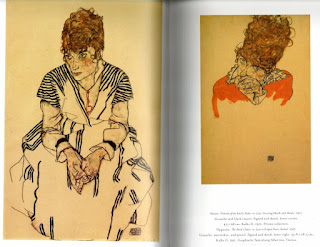In 1917, Egon declared that he wanted to start anew. The whole year was a busy and productive one. Egon spent time strengthening contacts with his old art patrons and friends. His military superiors took advantage of his artistic abilities and sent him to document supply depots and other outposts. While travelling on those assignments, he did many landscape drawings and paintings.
A bookseller created a portfolio of Egon's reproductions. They sold out quickly and Egon's related postcards sold well. For the first time in his career, Egon began to receive fan mail! He received inquiries from collectors and writers, and had many commissions. The War Museum asked him to help organize a war exhibition and Egon showed his work at the Munich Seccession of 1917.
Edith, at this time, felt completely left out of Egon's life. She complained that he never discussed his work with her. He used her less and less as a model. He began using his sister-in-law, Adele, as his model. Adele said she was not shy about posing nude and even claimed that she and Egon had an affair during this time. True or not, he did use her as a model often - we don't always know which models are Adele because she was a brunette (Edith was a blonde) and Egon painted many of his models with red hair (remembering Wally, his red-haired muse of the past?), not caring for the reality of their hair color.

Egon is using black crayon now instead of the soft pencil he used previously for his drawings. He becomes more concerned with volume and less with color. The number of nudes he does during 1917 exceeds the output from previous years.
Following a near sell-out exhibition at the 49th Vienna Secession of early 1918, Egon becomes widely known as the preeminent Austrian artist of his day (Gustav Klimt died in February of 1918 following a stroke). Egon was asked to take charge of organizing the Secession and he created a lithograph for the poster, using artist friends as the models (and placing himself at the head of the table and an empty chair for the deceased Klimt). Egon received the largest room at the Secession show and placed 19 oils and 29 works on paper - all sold out with a waiting list for more when the show ended! While some of his colleagues may have complained that Egon stole the show, they had to admit to his guidance and hard work to make the show a success for all of them.
Due to the success of the Vienna show, Egon now has a flood of requests from collectors, magazines and even theatres (he is asked to create sets). He has enough money to rent a large studio and hire professional models.
Egon is 27 year's old, and 1918 is only beginning...



12 comments:
I really love these art history lessons. I am such a Klimt fan, but I had never really studied Egon before, so I am learning a lot. I particularly love his gestural sketches. He showed so much with a simple line, didn't he?
Mary Beth, I have never read about Klimt and may put him on my list. Egon's work amazes me and you're right, it's the strength of the line that does it...
Rhonda, thank you again. I knew nothing about Schiele, plus you do really hard work printing.
Schiele's contour work is amazing - there is so much character and emotion in his line drawings.
Thanks for bringing this our attention - it is so interesting.
Hi Rhonda, You present a summary of Schiele's life in an interesting manner. I'd seen enough of his drawings before to recognize his distinctive style. But, I didn't realize he had success during his lifetime. Thank you!
Irinia, Barb and Peggy - I'm glad you've been enjoying my summaries of this book. It's well worth buying for Schiele admirers and drawing enthusiasts.
I finished reading my book several days ago, but I keep looking at the pictures. I look at Schiele's work; then I look at Lucian Freud's work; I see a similarity--probably in angles and squiggles of color.
Hallie, I've finished the book, too, and will post the final summary tomorrow, I think. I, too, keep looking through the book at the drawings and the paintings - love his figures and his angularity of lines. I'm looking at Lucien Freud's work on the blog that was posted recently, Paint Perceptions - good stuff. Another artist with a huge ego :) hee hee I wonder if the ego comes first or if the ego comes after being told how great he is for years and years?
I have Freud's gigantic book, and umpteen books on Bacon's work--my two favorite artists.
I actually suspect that, to be a great artist, there must be a great ego--probably from the start. Didn't Sciele expect to be be supported because of his talent?
Yes, he did expect to be supported but I wonder if that was due to his age (so young, really) rather than being an artist - could be a bit of both as he certainly did well in supporting himself and his wife later. But his time was cut so short...
Perhaps we have to feel like we are special and our work is unique and important to make others feel that way?
one of the greats. and good post on WKM's blog! lol
Hey, Nick. Yes, just think of what he could have accomplished if he'd had another couple of decades! I think you must mean the post of the couple and the man in front of the yellow :)
Post a Comment